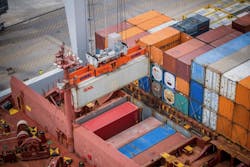DAT: Supply chain already feeling effects of Hurricane Harvey
As Hurricane Harvey continues to devastate Houston, the shocking images are drawing comparisons to Hurricane Katrina and New Orleans in 2005.
Unfortunately, Houston’s unique location means the supply chain is already feeling Harvey’s effects, even before the rain stops falling, according to executives with DAT load board.
“Katrina was a horrible storm that impacted homes, families, and business,” said Eileen Hart, DAT’s vice president of marketing and corporate communications. “With Houston, you have that, plus all of the freight that normally goes in and out of there. Now that freight has to get where it needs to go through other places.”
Matt Montague, DAT senior industry analyst, noted companies that have distribution centers in Houston are unlikely to have other facilities in nearby metropolitan areas such as Dallas. As a result, they need to ship freight from alternative areas to serve customers in and around Texas.
“That is why this has such a national impact,” he said. “It changes the shipping patterns, it increases the length of haul, and has a ripple effect throughout the supply chain.”
Houston, the nation’s fourth most populous city, is among the top six freight transportation hubs.
On the spot market, it is first in flatbed moves because of the energy industry that requires drilling rigs and pipes to be brought into the area, and results exports of industrial plastics and other products.
Houston has also seen strong growth in the dry van market, as imports of citrus from South America enter through the Port of Houston, which remains closed due to Harvey. In addition, it has become a major distribution point for fresh fruits and vegetables from the Rio Grande Valley, and is a critical artery in cross-border trade.
The storm will create major “ripple effects” for freight railroads and intermodal hubs, and will require re-routing of ocean cargo to ports on the East and West Coasts.
“This is going to take a long time to untangle,” said DAT market analyst Peggy Dorf.
Late last week, as the storm approached Texas, spot prices for intrastate van moves soared about 37 cents a mile from a week earlier. That was an indication shippers were “actively seeking to move truckload freight out of the storm zone, but to keep it within the state,” said Dorf.
Spot rates from Texas to other nearby states also spiked, she added.
While more current rate data was not yet available, Hart said more trucks are heading to staging grounds such as San Antonio and Dallas until they can safely reach Houston.
At the same time, the Federal Emergency Management Agency (FEMA) and American Logistics Aid Network (ALAN) are among the groups using the spot market and freight brokers to find hundreds of tractor-trailers and drivers to position emergency supplies to the region.
That is adding more complexity to an already busy week, as more shipments were planned ahead of the Labor Day holiday weekend, Montague said.
Looking ahead to when the storm passes and travel to Houston is declared safe, it comes as no surprise that inbound rates are expected to move higher, DAT said. That will include completing delayed shipments, as well as the initial shipments of heavy equipment and building materials as the region begins the slow rebuilding process.
About the Author
Neil Abt
Neil Abt is a former FleetOwner editor who wrote for the publication from 2017 to 2020. He was editorial director from 2018 to 2020.

